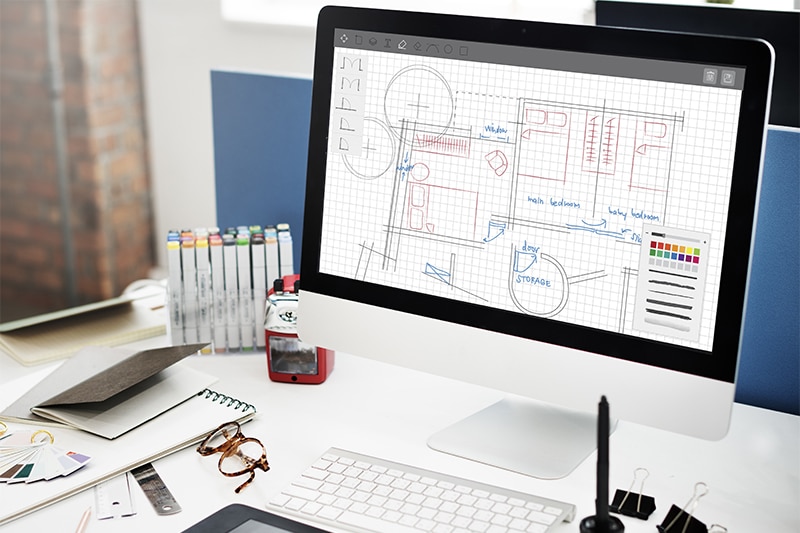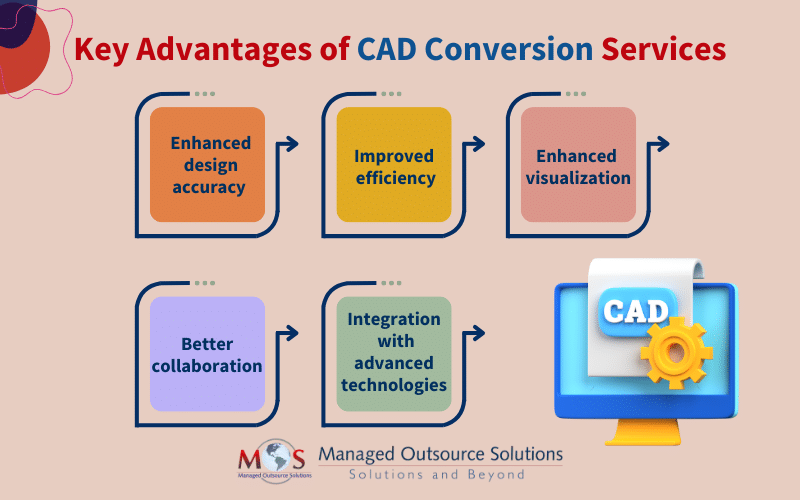What Are CAD Conversion Services?
CAD conversion services encompass a range of processes designed to transform various types of blueprints, drawings or other traditional design documents into digital CAD (Computer-Aided Design) formats. This process involves extraction and replication of physical files into an accurate, editable digital design format. These services are essential for professionals in architecture, engineering, construction, and manufacturing, as they help modernize workflows, improve accuracy, and enhance collaboration.
These services encompass various processes, such as:
- Assessment of 2D drawings
- Scanning and digitization
- Vectorization
- Validation and quality check
- Format conversion
- Delivery and implementation
By leveraging CAD conversion services, businesses can unlock benefits such as streamline project management, preserve important documents for future reference, and reduce operational costs. By utilizing CAD conversion services, organizations can effectively use modern design methodologies to develop, edit, and view complex designs with a high level of detail and clarity.
Key Benefits of CAD Conversion Services
CAD conversion services offer numerous benefits to businesses that wish to leverage the services for an optimal design development process, such as:
- Enhanced design accuracy – One of the primary advantages is the significant improvement in design accuracy. Manual drafting is prone to human error, but CAD software employs precise measurements with advanced design capabilities. This accuracy is crucial in fields such as architecture and engineering, where even minor errors can lead to costly mistakes and safety hazards.
- Improved efficiency – Streamlining the design process involves transforming paper drawings or outdated digital files into modern CAD formats. This seamless transition reduces the time spent on repetitive tasks such as symbol placements which significantly lowers the risk of human errors. As a result, projects can be completed faster, leading to increased productivity.
- Enhanced visualization – This enables the creation of realistic 3D models with interactive visualization features that enables iterative design refinement. This allows designers to experiment with design variations and produce design iterations effortlessly. The opportunity to visualize and test designs before product manufacturing enables designers to optimize solutions based on stakeholders’ feedback and project requirements.
- Better collaboration – Digital CAD files facilitate better collaboration among various professionals such as engineers, architects or manufacturers, as they can access designs easily, regardless of location. This interdisciplinary collaboration fosters creativity and streamlines communication, making it easier to gather feedback and implement changes in real time. A collaborative environment ultimately leads to better design outcomes.
- Integration with advanced technologies – Modern CAD software is designed to work seamlessly with a variety of digital tools such as 3D printing, 3D visualization or Building Information Modeling (BIM). Whether it’s project management software, simulation tools, or 3D modeling applications, CAD files facilitate integration into today’s production workflow. This interconnection enhances overall workflow efficiency and leads to better informed decision-making for producing a final output that aligns with business objectives.
Different Types of CAD Conversion Services
The landscape of CAD conversion services is diverse, offering a variety of solutions tailored to different needs across industries. A few of them are as follows:
- Paper to CAD conversion – Paper to CAD conversion is the process of transforming physical drawings, blueprints, or sketches into digital CAD files. This service is crucial for professionals looking to modernize their workflows and preserve old designs at the same time. By digitizing paper documents, organizations can also ensure better archiving and retrieval of important files into precise digital representations.
- 2D to 3D conversion – This process allows designers to visualize their concepts in three-dimensional format based on the physical blueprint. By converting 2D plans into 3D representations, clients can better assess design feasibility, and identify potential issues before construction begins. This type of conversion is particularly beneficial in architecture, engineering, and product design, where accurate 3D models are essential for effective decision-making.
- PDF to CAD conversion – Many organizations often distribute plans in PDF format due to its universal compatibility. However, these PDFs are not easily editable. PDF to CAD conversion services extract the design elements from PDFs and convert them into editable CAD files. This process preserves the original design’s integrity while allowing users to make modifications, updates, or detailed analyses. This service is essential for firms looking to update existing designs without needing to recreate them from scratch.
- Image to CAD conversion – This involves transforming raster images, such as photographs or scanned drawings, into editable CAD files. The conversion services scan the images of various formats such as GIF, TIFF, JPG, and BMP at a high resolution to capture all necessary details. Benefits of image to CAD conversion include enhanced quality and accuracy, making it suitable for detailed design work.
Why Utilize Outsourced CAD Conversion Services?
Outsourced CAD conversion services offer many benefits as it plays a vital role in industries such as architecture, automotive and healthcare. However, this is a technical process that requires specific skills and knowledge to create high-quality technical drawings and designs. As managing an in-house team is time- and resource- intensive, outsourcing these tasks to a reputable provider is an ideal solution for companies.
The benefits of outsourcing these are as follows:
- Access to expertise – Outsourcing ensures that your project is executed by a pool of skilled and knowledgeable experts adept at the latest CAD programs.
- Cost savings – As outsourcing helps to drastically reduce the need to invest in expensive software and in-house staffs, companies can save on time and money by minimizing overhead expenses.
- Customized solutions – With a dedicated team working on your project, the outsourcing partner can tailor their services according to your specific goals and requirements.
- Focus on core competencies – By delegating tasks such as converting paper drawings, PDFs, and raster images into editable CAD formats, businesses can concentrate on their primary operational functions to devote more time to strategic tasks, thus improving overall productivity.
Outsourcing CAD conversion is not just an advantage, but also a strategic decision for organizations to stay competitive in the dynamic and ever-changing market field. With outsourced solutions, businesses can optimize their operational efficiency, maneuver through complex designs with certainty and enhance overall production quality for maximum financial success.





